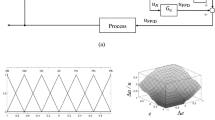Abstract
This article proposes a scheme for the on-line adjustment of three mode controller settings based on experimental measurements of closed-loop performance. It uses a recently developed heuristic tuning procedure to identify estimated process parameters. This method may give rise to conflicting estimates. Fuzzy Set theory is applied to manage the situation in terms of a fuzzy conjunction to combine the various estimates. PID control was chosen because of its wide use in the industrial environment due to driving simplicity and robustness. The article shows design, development, and computer simulation aspects.
Similar content being viewed by others
Explore related subjects
Discover the latest articles, news and stories from top researchers in related subjects.References
J.G. Ziegler and N.B. Nichols, “Optimum settings for automatic controllers,”Trans. ASME vol. 65, pp. 433–444, 1942.
F.G. Shinskey,Process-Control Systems McGraw-Hill: New York, p. 37, 1975.
K.J. Ästrom and T. Hagglund, “Automatic tuning of simple regulators with specifications on phase and amplitude margins,”Automatica vol. 20, no. 5, pp. 645–651, 1984.
C.C. Hang, T.H. Lee, and T.T. Tay, “The use of recursive parameter estimation as an auto-tuning aid,” inProc. ISA Annu. Conf., USA, 1984, pp. 387–396.
C.C. Hang, K.K. Sin, “On-line auto-tuning of PID controllers based on cross correlation,”Proc. Int. Conf. Ind. Electron., Singapore, 1988, pp. 441–446.
K.J. Ästrom, J.J. Anton, and K.E. Arzen, “Expert control,”Automatica vol. 22, pp. 277–286, 1986.
G.G. Acosta, M.A. Mayosky, and J.M. Catalfo, “Sistema de Producción aplicado a la sintonía de un Controlador PID,” inProc. XIII Jornadas de Ingeniería Eléctrica y Electrónica, Quito, Ecuador, July 1992, pp. 657–664.
E.H. Bristol, “Pattern recognition: an alternative to parameter identification in adaptive control,”Automatica vol. 13, no. 2, pp. 197–202, 1977.
T.W. Krauss and T.J. Myron, ‘Self-tuning PID controller uses pattern recognition approach,”Control Eng. vol. 36, no. 6, pp. 106–111, June 1984.
R.J. Mantz and E.J. Tacconi, “Complimentary rules to Ziegler and Nichols' rules for a regulating and tracking controller,”Int. J. Control vol. 49, no. 5, pp. 1465–1471, 1989.
R.J. Mantz and E.J. Tacconi, “A regulating and tracking PID controller,”Ind. Eng. Chem. Res. vol. 29, pp. 1249–1253, 1990.
C.C. Hang, K.J. Ästrom, W.K. Ho, “Refinements of the Ziegler and Nichols tuning formula,”IEE Proc. D vol. 138, no. 2, pp. 111–118, March 1991.
P.J. King and E.H. Mamdani, “The application of fuzzy control systems to industrial processes,”Automatica vol. 13, pp. 235–242, 1977.
F. van der Rhee, H.R. van Nauta Lemke, and J.G. Dijkman, “Knowledge based fuzzy control of systems,”IEEE Trans. Automat. Control vol. 35, no. 2, pp. 148–155, February 1990.
S. Tzafestas and N.P. Papanikolopoulos, “Incremental fuzzy expert PID control,”IEEE Trans. Ind. Electron. vol. 37, no. 5, pp. 365–371, October 1990.
L.A. Zadeh, “Fuzzy sets,”Inform. Control vol. 8, pp. 338–353, 1965.
L.A. Zadeh, “Fuzzy logic,”IEEE Computer, pp. 83–93, April 1988.
A. Kaufmann and M.M. Gupta,Introduction to Fuzzy Arithmetic: Theory and Applications Van Nostrand Reinhold: New York, 1985.
E. Rich,Artificial Intelligence McGraw-Hill: New York, pp. 84–87, 1983 (series in Artificial Intelligence).
Dote Yashuiko, “Fuzzy and neural network controller,” inProc. XVI Annu. Conf. IEEE Ind. Electron. Soc. (IECON '90), Asilomar, USA, November 1990, pp. 1314–1324.
Author information
Authors and Affiliations
Rights and permissions
About this article
Cite this article
Acosta, G.G., Mayosky, M.A. & Catalfo, J.M. An expert PID controller uses refined ziegler and nichols rules and fuzzy logic ideas. Appl Intell 4, 53–66 (1994). https://doi.org/10.1007/BF00872055
Received:
Revised:
Issue Date:
DOI: https://doi.org/10.1007/BF00872055




